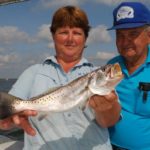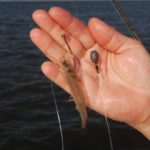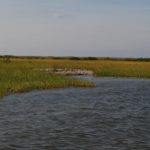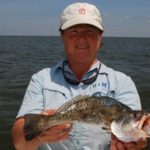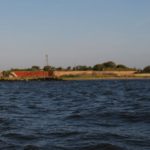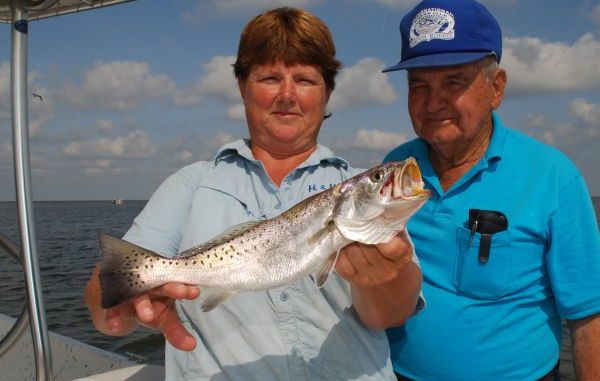
Many couples can’t work together, but this Grand Isle husband-and-wife team have great working relationship — and put their clients on tons of trout. Here are their secrets.
It wasn’t even 6:45 a.m. and the Bellanger fishing team had boated 20 speckled trout. They were anchored on a submerged, eroded island on the west side of Barataria Waterway within easy sight of Grand Isle.
Husband-and-wife charter-fishing teams are a rarity in Louisiana. Among the few are Jules and Pat Bellanger of Grand Isle. I figured I’d have some fun by pitting the pair against each other, with Pat calling the shots first thing in the morning and husband Jules taking command later in the day.
An added bonus would be the presence of family patriarch Arthur, Jules’ father.
In spite of the hot bite, only seven of them were big enough to keep, so Pat made the decision to move in search of larger fish. She piloted the boat down the waterway, through Barataria Pass and hooked a left to run down the beaches of Grand Terre Island.
As the boat neared the pass, Arthur, who it turns out is a close observer of all things Grand Isle, waved an arm broadly.
“During the BP oil spill, I worked six weeks picking up oil,” the elder Bellanger said. “Everything was black with oil, but the oil didn’t hurt anything.”
He said he had proof.
“A very good friend of mine, Ralph Adams, who was a Grand Isle alderman, used to fish under the oil wherever there was an oil spill,” Arthur Bellanger said. “He would catch beautiful trout under the oil.
“He would pinch the line between his finger and thumb as he reeled it in to strip the oil off the line.”
The octogenarian studied me closely, as if expecting a challenge.
Halfway down the island’s beach, Pat carefully idled the boat into the surf zone and dropped anchor in 3 feet of water.
Here the Bellangers changed rigs. Over the reef in the bay, they used live shrimp set under popping corks. Here, they used rods equipped with Carolina rigs and baited with live croakers.
They were within casting distance of the beach, and they cast to the very edge of the water and retrieved it a few feet into the trough between the beach and the first sandbar, where they explained trout like to travel.
The fishing was painfully slow, and Pat was clearly uncomfortable in the surf.
She pulled anchor to head back inside.
“I don’t like that,” she explained. “Jules fishes in the rollers; I don’t. There are places I want to check inside.”
The first stop was Bird Reef, a well-known Barataria Bay fishing location marked on all maps. The state has built the reef up, she explained, although the anchor went down in 5 ½ feet of water.
Shrimp were the anglers’ bait of choice here. They picked up a few small trout under a cork, but couldn’t get a bite on the bottom.
Up came the anchor again.
Next stop: the Coupe Abel reefs marked by three solitary pilings on the bay side of the eastern tip of Grand Terre Island.
Pat anchored the boat within casting distance of the pilings, all that remained of three oyster camps once perched on islands of shell and oyster grass. Many other pilings exist below water level, so a boater should be careful in the area, she cautioned.
The anglers alternated between tight-lining with Carolina rigs and corks, between croakers and shrimp, trying to find what the trout wanted.
“When you find what they want, they will change and then you have to change,” Pat grinned. “That’s my job when I guide. Once I get (customers) on fish, I will try other things to keep them on fish.
“I really don’t fish much when I guide.”
Four or five casts each with no bites provoked Pat to declare with finality, “They aren’t here; I’m going to leave.”
The run was short, across Coupe Abel Pass to a cove-like indentation on the north side of the remains of a grassy island. She anchored between a set of pipeline marker signs and the marsh grass. The water’s bottom was paved with oyster shells.
The bite here was better — not ferocious, but regular.
Pat bounced all over the boat, firing casts to probe every inch of the area. Arthur paused to watch her.
“She’s something else,” he said fondly. “She’s a hard fisherman.”
The spot produced a steady rhythm of fish, mostly on shrimp and mostly speckled trout from 12 to 16 inches, although a few small, perfect eating-sized redfish were added for variety.
Now it was Jules’ turn to take charge — and the tide had gone slack.
He promptly ran the boat back to the Grand Terre beach to a spot called the “Chimney,” the site of an old sugar mill on the island.
“Everybody knows this spot,” he quipped. “There are usually boats on it. Lots of people have it programmed in their GPS.”
Jules said the choice of locations was pretty simple.
“I came here because the tide is still slack,” he explained. “The beach is the best place to find moving water and the first place to get the effects after the tide change.
“I love the beach. It is usually the first place I head for early in the morning, although usually not in the middle of the day, like now.”
Both shrimp and croakers were presented alternately under cork and on Carolina rigs. Several small trout came in the boat, as well as a larger fish that Jules called a “Grand Isle trout.”
But the bite was too slow to hold his interest.
After pulling anchor, Jules piloted the boat deep into Barataria Bay to anchor near an oil platform and barge structure snug on the eastern side of the Barataria Waterway.
The spot didn’t yield a bite, so up came the anchor again.
After running partway down the waterway, Jules slowed the boat to inspect a wooden oil-well guard and a small, abandoned-looking platform.
“I’ve never caught anything here, but I’m going to give it a try,” he said. “I am always scouting.”
The cork plunged underwater on the first cast as a 1 ¼-pound speck grabbed his live shrimp. The rout was on; every cast produced a fish. Fishing was done fast, with the fish being quickly levered into the boat with long rods.
A broad grin finally split Jules’ face, sun-creased by a life in the outdoors.
“Life has been good,” he said. “I have always had a good job. We have all the seafood you could want to eat — crabs, shrimp and fish. Our kids never got into trouble; both are college graduates. We get to hunt and fish all the time. What more could you want?
“You’re not rich, but that depends how you define rich.”
